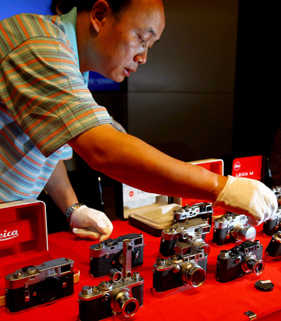Life and Leisure
Picture perfect Leicas an inspiration
By Liu Zhihua (China Daily)
Updated: 2010-12-02 07:57
 |
Large Medium Small |
Gregory Peck slung a Leica camera around his neck in the 1953 movie Roman Holiday, highlighting their iconic status. Fast-forward to today and the cameras are a focus of attention among collectors in China.
To emphasize this fact was an exhibition a few months ago called Leica Insight at the Beijing World Art Museum, which organizers claimed was the first in the world to offer a comprehensive account of Leica's history.
On display were about 20 photographs and over 300 Leica cameras, lenses and accessories.
A large number of the items belonged to Youxin Ye, 53, who was also a consultant for the exhibition.
Ye started collecting Leica cameras in the late 1990s in the United States and became the first and only Chinese CLA (Clean, Lubricate and Adjust) expert.
His love for the Leica dates back to his childhood. "I collect Leica cameras partly because my father used to have a Leica IIIC for work and when I think of my father this is one of my brightest memories," Ye says.
His father, Jiang Daquan, was an accomplished geologist, and one of former premier Zhou Enlai's consultants for the Three Gorges Dam hydro-electric project.
"My father was a workaholic. He was devoted to his country," Ye recalls.
|
|
Aged 10, Ye read a report about his father in an old magazine. The story gave a lively account of the inspection tour by his father and Zhou of Three Georges, and was accompanied by beautiful photos.
When he asked his father for more details, he showed him pictures he had taken with his Leica IIIC.
Though Ye was fascinated by the Leica camera, he never actually saw his father's, as he voluntarily turned it in to the authorities during the "cultural revolution" (1966-1976). In those days, even a made-in-China camera was considered a luxury, while a foreign brand camera was even worse.
On his father's deathbed, in 1987, Ye's father talked about his love for the Leica. For this reason Ye tried to buy a Leica IIIC in Beijing, but could only find a beat-up IIIf BD.
Ye emigrated to the United States in 1990 and was astonished by how far China lagged behind the West in terms of living standards.
"There were many Leica cameras on the market in the US, which were impossible to find in China," Ye says.
When he could afford one, in 1998, he bought a second-hand Leica IIIf BD.
Leica enthusiasts particularly value classic analogue cameras even though they require a lot of upkeep, such as lubricating and adjusting the mechanisms.
The camera Ye bought needed some work on it, but the cost, $250, was too much for him. He decided to learn how to repair it himself.
After a week of disassembling and reassembling the camera he discovered he had a knack for it and thought he could make some money from his newly discovered skills.
By day he worked as an accountant and at night he repaired rusty Leicas, not only his own but increasingly other people's cameras too.
"The Leica world is a small community. I became famous among Leica lovers through word of mouth," Ye says.
He also started collecting Leicas, initially focusing on commercial cameras and eventually built a substantial collection.
To complement the Leica Insight exhibition, Ye wrote Leica Insight, portraying the history of commercial Leica cameras, with previously unpublished photos from Leica.
"Leica is more than a camera brand. It is a paragon of German engineering prowess, and of Western civilization," Ye says.
"China can learn from this."
China Daily
